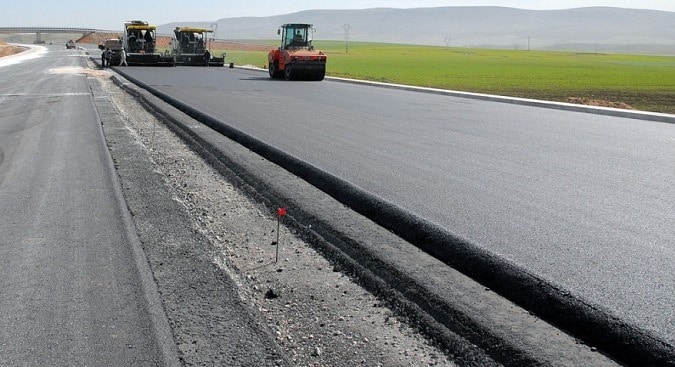As we are heading towards progressive times there is a need to adopt better technologies to keep pace with the changing norms.match our speed with numerous technologies surrounding us. Needless to say, the contribution of a well connected road network exhibits a country’s planning and growth strategies.
Roads have always created business opportunities for the private players. Lately, engineers and automakers have displayed their innovations with smart cars, autonomous technology, and vehicle communication systems. Now, advancements in technologies are changing the way roads are being constructed.
This would surely help innovate and improve the driving experience while also increasing roadway safety.
Though a road surface may just seem to be a layer of asphalt or concrete. But there is an abundance of products, techniques and treatments that save pavements from cracking to lessening traffic noise.
Few innovations that are driving the future of road construction can be listed as below.
- Using Asphalt To Reduce Noise Asphalt pavement reduces noise from traffic and highways and is much more cost effective than barrier walls, which can cost millions for small segments of roadways and may not provide as much noise reduction. In fact, noise tests using rubberized asphalt have shown a 50%-90% reduction in noise compared to traditional pavements.
- Using Precast Concrete Elements: Precast concrete for making road pavement can be installed rapidly which lowers disruptions to the traffic and enhance safety during construction. They also bring unmatched durability to the new roads and bridges.
- Solar Roads: Solar road panels are made up of super-strong glass and consist of photovoltaic cells, LED lights, and electrical wiring. Many countries around the globe these days are using solar panels, which are organized consecutively and are planned architecturally to drive cars upon the road. These are innovative and revolutionary replacements to support green communities. The idea of solar roads is to store the energy and then energy can convert into the form of electrical energy. The energy produced could be applied to bright the roads and bridges along with generate power for the local homes and the business. The key breakthrough of this development is the solar panel, which could store power.
- Eco-Friendly Technology: As the world is moving towards implementing sustainable ideas to achieve growth, the focus is on green technologies that is permeating the industry. Asphalt mixes are being developed that is safer for the environment.
- Eco-Friendly Materials: Manufacturers are contributing are fulfilling their responsibility towards the environment by making roads more sustainable with the usage of recycled material in the mix. As an added benefit, there are no petrochemical ingredients to contaminate run off water.
- Using Computer Modelling: As a new feature in engineering areas for road building, Computer modelling is being used extensively for designing structures, benefiting taxpayers and resulting in better performing roadways. With the help of this Engineers can test ideas and you can instantly see the impacts, including the cost impacts, of changes.
- Perpetual Asphalt Pavements: Perpetual pavement are also called long-lived pavement. It is a four-layer flexible asphalt pavement construction method. This type of advanced asphalt paving offers excellent strength to bear the precision structural fatigue. Such durable construction provides added value. Perpetual pavements are designed to last around 50 years, compared to 20 years for conventional pavements. The durability is due to the components of superior-performing asphalts and the ability to model and analyze road systems before construction.
In India, expressway construction is broadly based on Smart Pavement technology with the design and construction of Perpetual Pavement (PP) on a large scale. Perpetual Pavement was implemented in India for the first in the construction of the 8-lane Delhi Vadodara Expressway and various other greenfield corridors. These include the Bangalore-Chennai 4-lane Expressway, and the Delhi-Amritsar-Katra 4-lane Expressway.
The bottom layer in perpetual pavement, is a rich bottom mix, a specially designed mix packed with asphalt cement that is basically indestructible, and therefore highly resistant to cracking.
The middle and top layers are made of high-quality super pave asphalt mixes that resist rutting, cracking and wear. It requires repair work only after every 20 years or so and, because it only involves milling and replacing the surface, it can be done overnight.
Although they are too expensive for low-traffic-volume roads, perpetual pavements are predicted to become increasingly popular for major roadways.
- Full-Depth Reclamation: The conventional method of repairing roads involves removing the old asphalt pavement and hauling it off-site for disposal. In this technique the old asphalt is mixed with the underlying gravel and the resulting asphalt/gravel combination is used to form a new road base. The method of mixing the asphalt into the gravel has produced a better-quality base material. it saves the cost and environmental implications of removing the old asphalt from the site and reduces the amount of new aggregate used.
- Using Geopolymer Concrete: Geopolymers are also one of the innovative materials which are ceramic in nature and hence they are highly used for construction. Raw materials which are used to form rocks in their geological origins are used to create this silicon-based polymer material. The advantages of geopolymer have made it a highly discussed material. Geopolymer concrete uses ‘fly ash’ as a replacement for Portland cement. Fly ash is one of the most abundant industrial by-products available across the globe. The use of fly ash shows a tremendous huge impact on the strength of the material. Alternatively, the concrete may also use rice husk along with the binding agent which is not cement. Due to such ingredients, geopolymer concrete has potential benefits including a reduction in carbon emissions, use of wastewater and savings in energy consumption. It is also cost effective.
- High-Tech Stabilisation Technologies: Now, there are environmentally certified products manufactured by manufacturers that eliminates the need for multiple support layers in the road design, therefore reducing construction time and materials costs. The technology ensures longevity of the road with minimum maintenance.
- Self-Healing Technology: Self-healing technology has been advancing asphalt pavement design. Self-healing technology offers an alternative method for road maintenance, where the damage is repaired by an internal (implanted) healing system. The aim of self-healing technology is to enable material systems to heal after damage on a local or global scale. It aims to reduce the local or global level of damage and to extend or to renew the functionality and life-time of the damaged part, system or device.
This technology would redefine the way roads are being built. It is believed to eliminate maintenance and thus traffic disruption. It would save the natural resources that are needed to maintain the conventional roads.
Conclusion:
To ensure the safety of drivers and improve efficiency for public roadways, engineers are exploring new ideas implement newer and advanced technologies to construct roads. Needless to say that the current innovations in the field of construction of roads in challenging conditions is no more a herculean task because the binding agents and admixtures make it possible for the roads to last long and carry the heavy loads without cracking under tough environmental conditions. Use of recyclable materials for the construction of roads has added balance to the environment too. With the rise in the unstoppable traffic and tremendously increasing vehicular load, construction management techniques have become the need of the hour.
Thus, managing maximum traffic in optimal space is a demand in current scenario. Safe designing of roads, highway space management and proper drainage of water are major aspects that the engineers have to take care of.
Equipment used in modern technology for highway construction
The construction machines used to carry out the earthen works include excavators, loaders, dozers, graders and scrapers etc.
- Excavators- Excavators are used to dig the earth. They are commonly used in construction and they are essential part of the resources that are required for any building project. Loaders-They are also used for digging and to perform faster than the excavators. Their main function is to move loose soil.
- Dozers- The dozer machines are used for the surface to be constructed by moving and changing the soil. A dozer is a useful machine which pushes and spreads the soil to create a flat and even surface.
- Graders- The function of a grader is also similar to the dozer. It is used to smooth out the construction surface and level it also used for wet mix macadam. This equipment is particularly useful in road construction sites.
- Scrapers- Scraper is another type of construction equipment which is used to scrap a thin layer of soil.
- Road Work Machinery- All the functions involved in the construction of roads under this category. Road construction is a common application of the construction equipments.
- Milling Machine- The milling machine in road works is used for repair works to remove a layer of unwanted material from roads so that a new layer can be created by disposing off the destroyed layer.
- Bituminous Solutions– Bituminous and other temporary solutions are types of construction that are only suitable for use on very low-traffic thorough fares. Chip sealing techniques, thin membrane surfacing, and sealing are all examples of bituminous surface options.
The statistics cite India’s road network as one of the largest road networks in the world, spanning over 5.8 million km.Around 2% are National Highways, 3% are State Highways and the remaining belongs to district and rural road network. Over 64.5% of all goods in the country are transported through roads, while 90% of the total passenger traffic uses road network to commute.
PwC says that during the last five years there has been a significant growth in the road transportation network. The Government of India has allocated more than Rs 1.18 Lakh crore to the Ministry of Road Transport and Highways (MoRTH) as outlay for FY 2021-22. The government has identified various economic corridors to play an important role in transforming India’s economy to grow to USD 5 trillion by 2025. The importance to the sector is also highlighted by the fact that it accounts for approximately 18% of the National Infrastructure Pipeline. The importance of road infrastructure has been recognised and various state governments are considering to develop critical road corridors as a catalyst of economic development.
There are efforts from the GOI for the timely completion of projects,.Hence, the government has taken proactive measures to revive languishing projects, expedite land acquisition, provide enhanced focus on road safety, solve operational issues, provide time bound dispute resolution, and adopt technology enabled solutions.
Despite the Covid-19 pandemic,India achieved the highest national highway construction of 38 km per day, which at one point had started from 2 km per day. Secondly, at Delhi-Mumbai express highway near Vadodara, a 2.5 km 4-lane concrete road was made in 24 hours. Also, Solapur-Vijapur one-lane 20km bitumen road was made in just 22 hours.According to reports these roads have made a World record.
PwC report says that in India, recently the focus of the sector has been on road safety, green initiatives, digital transformation and augmentation of funding sources.
Key features of Green Highways Policy 2015
- Promote greening and development eco-friendly National Highway corridors across the country with participation of farmers, private sector and government institutions including Forest Department.
- It will address the issues that lie in the road of development and pave the way towards sustainable development.
- Objective: To reduce the impact of air pollution and dust by planting trees and shrubs along the National Highways. They will act as natural sink for air pollutants and arrest soil erosion at the embankment slopes.
- Stake holders: Contracts for greening highways will be given to NGOS, agencies, private companies and government organisations. These stakeholders will be responsible for the survival and health of trees.
- Planting of trees in any particular area will depend on the soil suitability and climatic conditions.
- Monitoring Agency: It will be responsible for monitoring the plantation status on continuous basis by carrying out the site visit for field verification to check survival, growth and size of plantation and maintenance of the same.
Performance audit of executing agencies will be regularly conducted by the agency on an Annual basis. New contracts will be awarded to the agencies based on their past performance audit.








